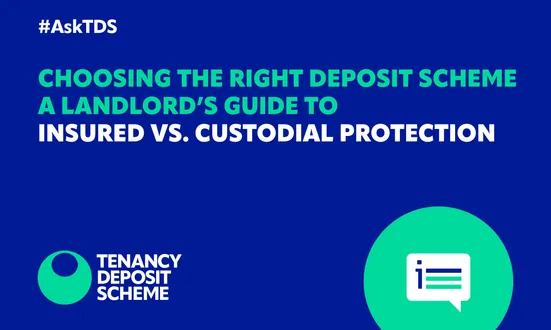With demand for pet-friendly rental homes continuing to grow, more landlords are being asked the question: “Can I bring my pet?” In this #ASKTDS, we explore how upcoming changes under the Renters Rights Bill are reshaping landlord responsibilities, and shares practical advice to help you manage pet requests with confidence.
The rise of pet-friendly rentals
Historically, most rental properties have advertised a strict ‘no pets’ policy, with only around 7% of private rental listings have been advertised as pet-friendly, even though roughly 51% of households in the UK own a pet. This mismatch means a growing number of prospective tenants are seeking pet-friendly homes but struggling to find them.
Landlords may worry that pets spell trouble such as damage to furniture, scratched floors, lingering odours, or complaints from neighbours. However, research is starting to challenge the negative reputation of renting with pets. A Battersea Dogs & Cats Home study found that 76% of landlords who allowed pets did not encounter any pet damage, and pet-owning tenants tend to stay longer in their tenancies. Longer stays can mean fewer void periods and more stable rental income. With demand for pet-friendly rentals increasing, landlords who can responsibly accommodate pets may tap into a larger pool of long-term, satisfied tenants.
New expectations under the Renters’ Rights Bill
The landscape is shifting. The Renters’ Rights Bill – currently concluding its passage through Parliament – proposes to give tenants greater rights to keep pets, which will likely raise expectations for landlords to consider pet requests. Under this bill, blanket “no pets” policies will effectively be outlawed. Consent for pets will become the default, and landlords will need a good reason to refuse a pet request. Tenants will have a legal right to ask for a pet, and landlords “cannot unreasonably refuse” such requests. If you do need to decline, you’ll have to respond in writing within 42 days (6 weeks) of the tenant’s request, stating a valid reason (for example, the pet is too large for the property, or a housemate has severe allergies).
It’s worth noting that currently the Tenant Fees Act 2019 caps tenancy deposits at 5 weeks’ rent, limiting the buffer for pet damage costs. Landlords may wish to consider insurance in order to help bridge that gap. Overall, the expected changes under the Renters Rights Bill mean that pet requests will become common and should be approached in a fair, case-by-case manner.
Practical tips for managing pet requests responsibly
If you decide to permit a pet (or are required to consider it), a proactive approach can protect your property and maintain a good landlord-tenant relationship. Here are some practical steps for handling tenant pet requests responsibly:
1. Gather details and communicate openly: When a tenant asks to keep a pet, start by learning as much as possible about the animal. Ask the tenant about the pet’s breed, size, and temperament, and whether it’s spayed/neutered, trained, and up-to-date on flea/worm treatments. Discuss how often the pet would be left alone and whether it tends to bark or cause any disturbances. If the tenant has rented with this pet before, consider asking for a reference from a previous landlord or even a vet to verify the pet’s behaviour. Open communication sets the tone that pets are acceptable only under responsible ownership. It also shows the tenant that you care about preventing problems, which can encourage them to be conscientious.
2. Update the tenancy agreement with a pet clause: It’s crucial to put in writing the rules and expectations if you’re allowing a pet. Add a clear pet clause in the tenancy agreement that spells out the tenant’s responsibilities for keeping the pet. Be specific! For example, require that the property is kept clean and free of pet odours, that the pet is not allowed to cause excessive noise or nuisance, and that pest control (flea treatment) and any additional cleaning or garden maintenance due to the pet are the tenant’s responsibility. Include details like the number and type of pets permitted (e.g. one cat, or a dog under 20kg – whatever you agree on) so there’s no ambiguity. Also, prohibit any animals classified as dangerous (you can reference the Dangerous Dogs Act breed list, for instance). A well-crafted pet clause protects you if things go wrong because it documents that the tenant agreed to certain standards of pet care and property care. This will make it easier to justify deposit deductions or other actions later if the pet causes damage or rule breaches. Always ensure the tenant countersigns this clause, acknowledging their obligations.
3. Document the property’s condition: Before the pet moves in, perform a thorough check-in inventory with the tenant present. Detail the condition of every room, item, and surface in the property. It’s wise to take dated photographs of floors, carpets, furniture, doors, gardens, etc. as evidence of their pre-pet state. This record is invaluable later, as if the pet causes damage, you can clearly compare the move-in vs. move-out condition to support a claim. In addition to the start-of-tenancy inventory, plan for a check-out report at the end of the tenancy that similarly notes the property’s state in detail. The check-out report should be cross-referenced with the inventory to highlight any changes beyond normal wear and tear. For example, if a door frame now has chew marks or the garden turf is dug up, it will be evident when compared side by side.
4. Conduct regular inspections: Don’t just set it and forget it! It’s advisable to inspect the property periodically in line with what’s allowed in your agreement, to catch any pet-related issues early. During these mid-tenancy property checks, look for signs of damage or neglect: stains, scratches, pet hair accumulation, or pest issues like fleas. If possible, take photos during inspections as well, especially if you spot budding problems, so you have dated evidence. If you do notice something concerning – say claw marks on the banister or a strong pet smell – address it with the tenant in a friendly but clear manner. Early, constructive conversations can prevent minor issues from growing into major damage. Remember to always give proper notice to your tenant before inspections, and be reasonable with frequency.
5. Plan for the worst (risk management): Even with a responsible tenant and a well-behaved pet, accidents can happen. Clawed carpets, chewed woodwork, or stained upholstery are potential risks when renting to pet owners. One important safeguard is to ensure the tenant’s deposit is protected in a government-approved scheme and that the tenancy agreement allows you to use it for pet damage. If the pet does cause damage beyond fair wear and tear, you can propose reasonable deductions from the deposit to cover repairs or extra cleaning, as long as the pet clause clearly put those obligations on the tenant. In cases of serious damage that exceed the deposit amount, having additional protection is wise. This is where pet damage insurance comes in as another layer of risk management.
Extra safeguard: TDS & SafeHouse’s pet damage insurance
In light of these pet-friendly developments, the industry is also providing new tools to help landlords cope. Notably, TDShas partnered with SafeHouse Insurance to launch a dedicated pet damage insurance policy for rental properties. This optional policy is designed as a safety net to cover pet-related damage that might go beyond the normal wear-and-tear or beyond what the deposit covers.
So, how does a pet damage policy work and why might you consider it
Pet damage insurance is designed to cover the cost of repairs or extra cleaning if a pet causes accidental damage to the property during the tenancy.
While landlords typically look to the deposit first to cover any damage, pet damage insurance can step in if the costs exceed the deposit or if the policy terms allow direct claims. It acts as an extra layer of reassurance, complementing your existing landlord insurance, particularly as many standard policies exclude pet-related damage.
Importantly, this type of cover is optional, but with the upcoming Renters Rights Bill potentially making it easier for tenants to keep pets, this can give landlords a clear and fair way to manage risk while supporting tenants who want to rent with pets.
Exclusively for TDS Members
TDS has partnered with Safe House Insurance to offer tailored landlord and tenant insurance products. Get affordable, reliable coverage with exclusive deals through TDS Landlord+.
About TDS
The Tenancy Deposit Scheme is part of The Dispute Service (TDS), the largest tenancy deposit protection (by value) and resolution service provider in the UK making life easier for tens of thousands of agents, landlords, developers, and millions of tenants and homebuyers.
We provide a free Custodial tenancy deposit protection scheme, or join our Insured tenancy deposit protection scheme, which offers the best rates for agents and landlords.
Protecting deposits with TDS is quick and easy.
Other news stories


